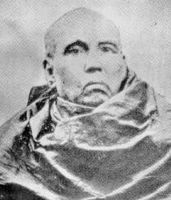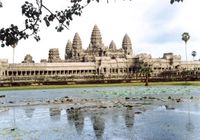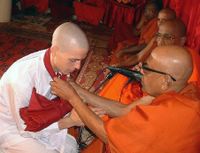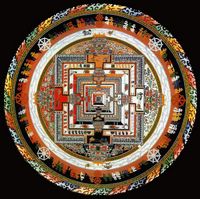N0. 0028
SỰ PHỤC HƯNG PHẬT GIÁO Ở ẤN ĐỘ
(Đại Đức Prayudh Payutto)
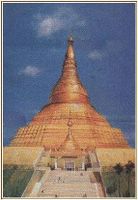 The Revival of Buddhism in India
The Revival of Buddhism in India

Vào năm 1200 sau Công nguyên, Phật giáo hoàn toàn biến mất khỏi Ấn độ và người dân Ấn hầu như quên hẳn Phật giáo. Mãi cho đến giữa thế kỷ thứ 18 người ta mới có ý thức rõ rệt về sự tồn tại và một thời hoàn kim của Phật giáo. Sự kiện này được xem như là khởi đầu cho giai đoạn hiện đại của Phật giáo ở Ấn độ.Bắt đầu là việc một nhân viên người Anh phát hiện ra một mảnh vỡ từ bia ký trên cột trụ đá của vua A Dục ở Delhi. Sau đó người ta phát hiện thêm nhiều mảnh khác, và việc nghiên cứu các bia ký của vua A Dục cùng với sự quan tâm đến các truyền thống Phật giáo phát triển dần. Năm 1819, động Ajanta, một hang động có các công trình điêu khắc Phật giáo vĩ đại, được 2 người lính Anh tình cờ phát hiện. Tháp Sanchi được phát hiện năm 1851 và được khai quật bởi nhà khảo cổ học người Anh nổi tiếng là Alexander Cunningham. Sau đó có hàng loạt các phát hiện khác, nên việc khai quật và phục hồi các di tích Phật giáo được thực hiện rất mạnh mẽ. Lịch sử huy hoàng của Phật giáo được bộc lộ, tầm cỡ của Phật giáo được phát hiện đã khiến cho người dân Ấn độ cũng như thế giới bắt đầu chú ý đến.Công việc của các nhà thám hiểm và khảo cổ học được tiếp nối bằng hoạt động văn học của các học giả phương tây từ năm 1826. Việc phiên dịch và phiên âm Tam tạng Pali cùng với các bộ luận, chú giải, sử Phật giáo, sách văn phạm, các khảo luận về Phật giáo và ngôn ngữ Pali, các bộ từ điển Pali được soạn thảo bởi các học giả của các nước Anh, Pháp, Đức, Hà lan, Mỹ, v.v… Việc thành lập Hội Pali Text Society ở Luân đôn bởi Giáo sư Rhys Davids năm 1881 là một bước tiến rất lớn trong việc nghiên cứ Pali. Văn học Phật giáo Sanskrit cũng như các nền văn học Hán Tạng và Tây Tạng cũng phát triển mạnh. Ở Anh, các tác phẩm nghiên cứu Phật giáo được thực hiện đều đặn và không gián đoạn cho đến tận ngày nay và đã đóng góp rất lớn cho ngành nghiên cứu Phật học. Pháp và Đức cũng có những cống hiến đáng kể. Tuy nhiên Hoa kỳ, tuy đi sau, nhưng lại là nước dẫn đầu trong việc nghiên cứu và xuất bản các tác phẩm Phật giáo, đặc biệt là những năm gần đây.Sự nỗ lực của các học giả phương tây đã làm thức tỉnh các học giả Ấn Độ. Hội Văn Học Phật giáo được thành lập năm 1892 ở Calcutta. Dần dần Santiniketan, Patna, và Nalanda ở phía đông Ấn và Bombay, Puna, và bảoda ở Tây Ấn cũng trở thành các trung tâm nghiên cứu Phật giáo. Cùng các hoạt động văn học, việc phục hưng Phật giáo ở Ấn độ trở thành một phong trào có tổ chức với sự thành lập của Hội Phật giáo Maha Bodhi Society năm 1891.Người sáng lập Hội Maha Bodhi Society là Dharmapala, một Phật tử trẻ người Tích Lan. Năm 1885, Edwin Arnold, tác giả của cuốn Ánh sáng Á Châu (The Light of Asia) đến thăm Bồ Đề Đạo Tràng, lúc đó đang ở trong tay của người Hindu và bị bỏ phế một cách thê thảm. Ông viết một loạt bài báo đăng trong tờ London Telegraph để nói về sự kiện này. Xúc động với những bài báo của Edwin Arnold, Dharmapala đến thăm Bồ Đề Đạo Tràng và sửng sốt trước cảnh điêu tàn ở đây. Ông phát nguyện sẽ dành trọn cả đời mình cho việc lấy lại các Phật tích cho Phật giáo và cho việc phục hưng giáo pháp cao thượng trên quê hương của Đức Phật.Dharmapala trở về Tích Lan năm 1891 và thành lập Hội Maha Bodhi Society ở Colombo. Cùng năm đó, một phái đoàn truyền giáo được cử sang Ấn độ và một hội nghị Phật giáo thế giới được tổ chức ở đây. Năm sau, một tờ báo được khai trương và trụ sở của Hội đặt ở Calcutta. Các chi nhánh của Hội được thành lập ở nhiều nơi, và năm 1920, một ngôi chùa Phật giáo được thành lập ở Calcutta. Đến đây thì phong trào phục hưng Phật giáo đã phát triển mạnh và được duy trì đều đặn. Dharmapala xuất gia năm 1931 và qua đòi sau đó hai năm. Các đồng sự và đệ tử của ông thay ông thực hiện những sứ mạng mà ông chưa kịp hoàn thành.Ấn độ giành được độc lập ngày 15 tháng 8 năm 1947. Khi chọn quốc huy cho đất nước Ấn độ vừa mới tự do, Hội Đồng lập pháp Ấn độ đã quay về với di sản Phật giáo. Hình ảnh bánh xe pháp được đặt ngay giữa trung tâm của lá cờ để nhắc nhở cả dân tộc về giáo lý của Đức Phật cũng như cuộc chinh phục bằng công bằng và lẽ phải của vua A Dục. Biểu tượng đầu sư tử của vua A Dục, biểu tượng cho sự truyền bá giáo pháp một cách mạnh mẽ, can đảm đi khắp bốn phương, được chọn làm quốc huy của Ấn độ. Chủ tịch hội đồng soạn thảo Hiến pháp, Tiến sĩ Ambedkar, là người đứng đầu đẳng cấp thấp kém nhất của Ấn độ, đẳng cấp Thủ đà la, đã hướng dẫn họ quy y Phật giáo và biến sự phục hưng Phật giáo thành một phong trào của đại chúng.Hai sự kiện khác làm gia tăng sự quan tâm của quần chúng Ấn độ đối với Phật giáo là lễ cung nghinh xá lợi của hai vị đại đệ tử của Đức Phật năm 1949, và lễ kỷ niệm 2500 năm ngày Đức Phật nhập Niết bàn năm 1956. Xá lợi của ngài Mục Kiền Liên và ngài Xá Lợi Phất đã được chính phủ Anh trả về Ấn độ để thờ ở tháp Sanchi, chính nơi mà ngày xưa người ta tìm thấy, theo lời yêu cầu của Hội Maha Bodhi Society. Lễ cung nghinh xá lợi hai ngài đại đệ tử được tổ chức cùng vơi lễ kỷ niệm 50 năm ngày thành lập hội Maha Bodhi Society và Hội nghị Phật giáo thế giới với sự tham dự của thủ tướng Ấn độ và Miến Điện cùng với các nhà lãnh đạo Phật giáo thế giới. Lễ Phật Đản Phật lịch 2500 bắt đầu vào tháng 5 năm 1956 và kéo dài suốt cả một năm, cho đến tháng 5 năm 1957. Chính phủ Ấn độ cho xuất bản toàn bộ Tam Tạng Pali bằng mẫu tự Devanagari, và cuốn “2500 năm Phật giáo” là một tập sách đánh dấu cho sự cung kính của tầng lớp trí thức Ấn độ đối với Phật giáo.Ngày 14 tháng 10 cùng năm đó, Tiến sĩ Ambedkar dẫn đầu nửa triệu người trong buổi lễ chính thức quy y Phật giáo. Theo sau sự kiện này, rất nhiều người bỏ Ấn độ giáo để theo Đạo Phật, đặc biệt là những người thuộc đẳng cấp thấp mong cầu có bình đẳng xã hội. Đến năm 1965 đã có 4 triệu Phật tử ở Ấn độ so với con số 50 000 năm 1891. Số lượng chư tăng, chùa chiền và các tổ chức Phật giáo cũng gia tăng đáng kể. Năm 1908, môn học Pali đã được đưa vào trường Đại học Calcutta, và các trường đại học khác ở Ấn độ cũng làm tương tự. Viện Nghiên cứu Pali ở Nalanda được thành lập năm 1951, và trường Đại học Ma Kiệt Đà được thành lập năm 1962 cho thấy việc nghiên cứu Pali và Phật pháp đã rất được chú trọng ở Ấn độ.Năm 1950, rất nhiều chư tăng và Phật tử Tây Tạng đến tỵ nạn ở Ấn độ. Cộng đồng Phật giáo Tây Tạng cũng là một đóng góp đáng kể cho tương lai của Phật giáo ở đây.Chỉ cách đây một thế kỷ, Phật giáo không hề được nhắc đến trên xứ Phật, vì hầu như mọi vết tích của Phật giáo đã bị xoá sạch. Thế nhưng ngày nay, hạt giống của cây bồ đề giác ngộ, được ấp ủ từ lâu trong lòng đất, đã được tưới tẩm với bàn tay của những người con Phật từ khắp nơi trên thế giới, đã nảy mầm và bắt đầu lớn mạnh.
(Liễu Pháp dịch)
The Revival of Buddhism in India
Bhikkhu Prayudh Payutto
I. A General View of the Buddhist Situation
The light of Buddhism was extinguished in India around B.E. 1700/ c. 1200 C.E. In Malaya and Indonesia Buddhism ran the same course of decay. At first, around 1857/1314, it degenerated into a Hinduized form. Before the end of the fourteenth century (1900 B.E.), together with Hinduism, it was replaced by Islam imported from India. In Southeast Asia, as Theravada, and in North Asia, as Mahayana, Buddhism continued to glow. Then came again the age of decay. In China and Korea from B.E. 1900,onwards, the revival of Confucianism in accord with the state Policy of nationalism brought Buddhism under suppression. The revival of Shintoism in Japan also led to the suppression of Buddhism in 2411/1868. In Southeast Asia the decay came with the advent of colonialism from the West. In Ceylon, the task of suppressing Buddhism, begun by the Portuguese in 2050/1507, was carried on by the Dutch around 2200/1657 and then by the British since 2340/1797. In Indochina, it persisted until Burma was made a British colony in 2367/1814, and Vietnam, Cambodia and Laos were brought under French rule in 2426, 2406 and 2436 (1883, 1863 and 1893 C.E.) respectively. In Thailand alone, the religious life of the people remained unaffected and Buddhism continued to flourish with the support of the ruler and the public throughout the colonial period without any interruption. After some time the contact with the West, its colonialism and its civilization, brought about remarkable changes in the faces of the Asian nations. In countries under foreign occupation where Buddhism was suppressed and persecuted, people turned against Western civilization and a strong urge was aroused in them to protect and maintain their national heritages. This led to the revival of Buddhism and the adjustment of Buddhist institutions and the monkhood to function efficiently in the changing situations. However, in Thailand where people did not experience colonial treatment, this reaction did not take place. On the contrary, the people turned their attention towards the exciting and tempting materialism of Western civilization. While they pursued this new kind of material quest, they became more and more indifferent and cold towards their religious traditions. Buddhist institutions enjoying luxurious support fell into a kind of indulgence and did not adjust themselves to the changing conditions. Material support and cooperation continues to grow, while the intellectual and spiritual gap widens. II. Western Scholars and the Buddhist Revival After four or five centuries of stagnation, the period of revival began nearly at the same time in Japan, around 2411/1 868, and in Ceylon, around 2414/1871. In Japan, the suppression and persecution during the Meiji era acted as a stimulus, while in Ceylon the revival was aroused partly by the colonial suppression and partly by the awareness of Buddhist traditions in its homeland. In India Buddhism was completely forgotten by the Indian people and it was not until the middle of the eighteenth century that there was an awareness of her existence and prosperity in the past. This awareness may be regarded as the beginning of the modern period of Buddhism. It happened that in 2293/1750 a broken piece of an Asokan pillar inscription was discovered by a British official in Delhi. Then followed many other discoveries, the study of Asokan inscriptions and the interest in Buddhist traditions which increased through the years. In 2362/1819. The Ajanta cave was accidentally discovered by two British soldiers. The great stupa at Sanchi was discovered and in 2394/1851 was opened by Sir Alexander Cunningham. There were large numbers of subsequent discoveries. An active work of excavation and restoration of Buddhist archaeological sites was carried on. The glorious history of Buddhism was revealed, its greatness discovered and brought back to the interest both of India and of the world. The work of explorers and archaeologists was followed by literary activities of Western scholars from 2369/1826 onwards. Translations and transliterations of the Pali canonical literature, treatises, commentaries, chronicles and grammar, essays and treatises on Pali and Buddhism, and Pali dictionaries were made by scholars of different nationalities: English, French, German, Danish, Dutch, American, and others.[1] The founding of the Pall Text Society in London by Prof. T.W. Rhys Davids in 2424/1881 was a great step forward in Pali studies. The Society has published to date nearly the whole of the Pali Canon and all the important works of the Pali non-canonical literature together with their translations (a larger number than scriptural publications in Thailand). Special mention should be made of lexicography. The well-known Dictionary of the Pali Language by R.C. Childers published in London in 2418/1875 is regarded as the first advance in this field. When this work was found inadequate, the Pali Text Society published the "Pali-English Dictionary" edited by T.W. Rhys Davids and William Stede (2464-68/1921-25), which is still the main reference for all students of Pali. This was followed by 'A Critical Pali Dictionary' by Dines Anderson and Helmer Smith, the first part of which was published in Copenhagen in 2470/1927. However, only two volumes of it in twenty-one parts (a - uparima, in 1085 pages) have been published so far. In London, Pali scholars have also been preparing for the Pali Text Society "Pali Tipi.taka"m Concordance" about 1340 pages (a - pura) of which have been published since 1952. Great advances have also been made in the study of Sanskrit Buddhist literature both in the original and in later versions, especially in Tibetan and Chinese. In England, Buddhist publications and researches have followed to the present an unbroken line and contributed greatly to the steady progress of Buddhist studies. France and Germany have also made considerable contributions. It is, however, the United States that is stepping forward to take the lead in Buddhist publications and research works. Rapid progress was made during recent years. The labours of Western scholars brought about an awakening among the scholars of India. The Buddhist Text Society was founded in Calcutta in 2435/1892 and the pioneer work in the field of Buddhist studies was done in Bengal. In the course of time Santiniketan, Patna and Nalanda in eastern India and Bombay, Poona and Baroda in western India became active centres of Buddhist studies.[2] Alongside literary activities, Buddhist revival in India began as an organized movement with the founding of the Maha Bodhi Society in 2434/1891. III. Ceylonese and Indian Contributions The founder of the Maha Bodhi Society was Anaagaarika Dbarmapaala, a young Buddhist of Ceylon. Dharmapaala was born in 2407/18642 in a wealthy and influential Buddhist family in Colombo. His personal name was Don David Hewavitharne. He was educated in a Christian missionary school. As he could not love his wine-drinking and pleasure-loving missionary teachers, he developed an attachment towards Buddhist monks who were meek and abstemious. Under the influence of Colonel Olcott and Madame Blavatsky he took an interest in Theosophy and then adopted a life of religious dedication as an Andgdrika. In 2428/1885, Sir Edwin Arnold, the author of The Light of Asia (a long poem about the Buddha, which made many converts and stimulated scholarly study of Buddhism), visited Bodh Gaya (or, in Pali, Buddha Gayaa) which was in the hands of the Mahants, Hindu Shaivites, and was shamefully neglected. He pointed out this fact in a series of articles in the London Telegraph. Inspired by Sir Edwin Arnold's articles, Dharmapaala visited Bodh Gaya and was so shocked at what he saw that he made a vow to dedicate his life both to the task of restoring the Holy Place to Buddhist hands as a worthy place of pilgrimage, and to the revival of the Noble Dharma in the land of its birth. Dharmapaala returned to Ceylon in May 2434/1891 and founded the Maha Bodhi Society in Colombo. In the same year, a mission was sent to Bodh Gaya and, then, an international conference of Buddhists was held there. In the following year a journal was launched and headquarters of the new society were set up in Calcutta. Dharmapaala visited the United States two times during the 1890's, the first time to attend the Parliament of Religions in Chicago, when he visited Hawaii, Japan, China, Thailand and Malaya on his way back, and the second time to preach Buddhism when he stayed there for one year and made several American converts. Substantial financial help came from wealthy Americans, especially Mrs. Mary E. Foster whom he met in Honolulu and who became his most active supporter. Further branches of the Society were set up and in 2463/1920 a Buddhist Vihara was opened at Culcutta. The revival movement was then well founded and continued steadily. Dharmapaala entered the monkhood in 2474/1931 and passed away two years later, leaving his unfinished mission to be carried on by his colleagues and followers. , India achieved independence on August 15, 2490/1947. When questions arose as to what should be adopted as national symbols of free India, the Constituent Assembly ultimately turned towards the Buddhist heritage. Thus, the Dharma-cakra or the Wheel of the Law came to be represented at the centre of the national flag to remind the nation of the noble doctrine of the Buddha and of the Dharma-vinaya or Conquest by Righteousness of Asoka, while the Lion Capital of Asoka, representing the fearless proclamation of the Dharma to the four quarters of the world, has been adopted as the official seal of the Republic. The Chairman of the Committee which drafted the Constitution was Dr. B.R. Ambedkar, the leader of the untouchables who became converted to Buddhism and made the Buddhist revival a mass movement. Two other important events increased the interest in Buddhism among the Indian masses, the home-coming of the sacred relics of the two Chief Disciples of the Buddha in 2492/1949 and the Buddha-Jayanti or 2500th anniversary of the Buddha's Parinirvaana, in 1956. The relics were returned to India by the British Government to be enshrined at San chi, their original resting place, on the request of the Maha Bodhi Society. The enshrinement of the relics was celebrated together with the Maha Bodhi Society's Golden Jubilee and an international Buddhist conference attended by the Prime Ministers of India and Burma and world Buddhist leaders. The Indian Buddha-Jayanti celebrations commenced in May 1956 and lasted for one full year, till May 1957. The programme of the Government of India includes the publication of a Tripitaka in Devanaagarii script and '2500 Years of Buddhism,' a special volume which is an indication of the respect given to Buddhism by the Indian educated class. On October 14 of the year of celebration, Dr. B.R. Ambedkar led half a million followers in a formal declaration of adherence to Buddhism. This event was followed by a fast increase in the Buddhist population in India, particularly through a number of similar conversions among the untouchables seeking social equality. By 2508/1965 there were about 4,000,000 Buddhists in India in contrast to 50,000 in 2434/1891. Numbers of 13 Bhikkhus, Viharas, and Buddhist societies and organizations have also considerably increased. The study of Pali was introduced into Calcutta University as far back as the year 2451/1908. This example has been followed by many other Indian Universities. The establishment of the Naalanda Pali Institute (Nava Naalandaa Mahaavihaara) in 2494/1951 and the founding of the Magadh University in 2505/1962 are also evidences of an important place modern India has given to Pali and Buddhist studies. In the 1950s, when the Red Chinese overran Tibet, her people, both monks and laymen, fled to north India and found refuge in her hill country. There, a Buddhist community is taking shape and Tibetan Buddhism may make a significant contribution to the future of Indian Buddhism. A Thai monastery called Wat Thai Buddha-Gaya, which was constructed by the Thai Government on the invitation of the Government of India to celebrate the Buddha-Jayanti, was completed in 2509/1966. It is well known as one of the finest vihaaras ever constructed in modern India. The Burmese, Japanese, Chinese and Tibetan Buddhists also have monasteries at Buddha Gaya. Just a century ago Buddhism was unheard of in the land of its birth, as nearly every trace of the religion had been effaced from the Indian soil. Today, the seed of the Bodhi tree, deeply planted under the soil, being fed by fertilizer from abroad, has sprouted and has signs of a glorious growth. In some border areas of India such as some parts of Assam and in Bangladesh (East Bengal), Buddhism has never entirely disappeared. There the monastic life still survives and a small Buddhist population has persisted. Notable in this way is Chittagong, which has been closely connected with Burma both historically and geographically; there the monkhood consists of hundreds of monks and novices.[3] Through some revival movement, Buddhism in these areas has begun to grow again and may do a good service to the development of modern Buddhism on the Indian Subcontinent.
